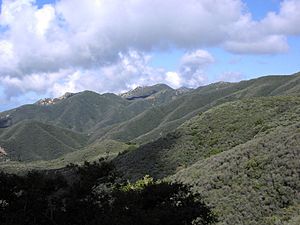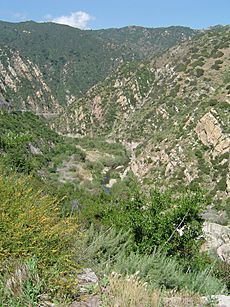California chaparral and woodlands facts for kids
Quick facts for kids California chaparral and woodlands |
|
|---|---|
 |
|
| Ecology | |
| Realm | Nearctic |
| Biome | Mediterranean forests, woodlands, and scrub |
| Geography | |
| Area | 121,000 km2 (47,000 sq mi) |
| Countries | United States and Mexico |
| States | Oregon, California and Baja California |
The California chaparral and woodlands is a special natural area, or ecoregion, found along the west coast of North America. It stretches across parts of southwestern Oregon, much of California in the United States, and northwestern Baja California in Mexico. This ecoregion is known for its unique plants and animals. It's part of a larger group of similar places around the world called the Mediterranean forests, woodlands, and scrub biome.
Contents
What is this Ecoregion Like?
Three Main Areas
The California chaparral and woodlands ecoregion is actually made up of three smaller, distinct areas. Each has its own special features:
- California coastal sage and chaparral ecoregion: This area is found along the southern coasts of California and northwestern Baja California. It also includes all the Channel Islands and Guadalupe Island.
- California montane chaparral and woodlands: This part covers the mountains in central and southern California. It includes parts of the Coast Ranges, the Transverse Ranges, and the western slopes of the northern Peninsular Ranges.
- California interior chaparral and woodlands: You'll find this ecoregion in central California, surrounding the California Central Valley. It covers the foothills and parts of the Transverse Ranges and Sierra Nevada mountains.
Where People Live
Many people in California and Baja California live within these ecoregions. Big cities and areas like the San Francisco Bay Area, Ventura County, the Greater Los Angeles Area, San Diego County, and Tijuana are all here.
Nearby ecoregions, like the California Central Valley grasslands and the Sierra Nevada forests, share many plants and animals with the chaparral and woodlands.
Amazing Plants
This ecoregion has a huge variety of plant life. You can find grasslands, oak savannas, woodlands, chaparral, and even coniferous forests. Some of the tall coast redwood trees (Sequoia sempervirens) grow here.
Other interesting trees include the Gray or foothill pine (Pinus sabiniana) and the Scrub oak (Quercus dumosa). You might also see the California buckeye (Aesculus californica). There are also rare trees like the Gowen cypress (Cupressus goveniana) and the Monterey cypress (Cupressus macrocarpa).
Many plants here are endemic, meaning they grow only in this area. Examples include the very rare San Gabriel Mountain liveforever (Dudlea densiflora) and the Catalina mahogany (Cercocarpus traskiae). The Hesperoyucca whipplei, also called Chaparral Yucca, is very common at lower elevations.
There are two main types of chaparral:
- Soft chaparral usually loses its leaves during dry periods. It grows at lower elevations and is easier to walk through.
- Hard chaparral stays green all year. It's found at higher elevations and is much tougher to move through.
Cool Animals
This ecoregion is home to many different animals. You might spot the California gnatcatcher (Polioptila californica) or the colorful Costa's hummingbird (Calypte costae).
Reptiles like the coast horned lizard (Phrynosoma coronatum) and the rosy boa (Lichanura trivirgata) live here. Small mammals include the Heermann kangaroo rat (Dipodomys heermanni) and the Santa Cruz kangaroo rat (Dipodomys venustus). The endangered white-eared pocket mouse (Perognathus alticolus) also calls this place home.
A unique insect here is the rain beetle (Pleocoma sp.). It spends years as a larva underground. It only comes out during the wet season rains to find a mate.
Fires in the Chaparral
Chaparral plants are very good at recovering from fires. Historically, large, intense fires would happen every 30 to 100 years. Native Americans used to burn chaparral to create grasslands for growing plants and finding food.
Even though chaparral is adapted to infrequent fires, too many fires can destroy these plant communities. This is especially true with droughts caused by climate change. Today, fires started by humans happen much more often, sometimes every 5 to 10 years. This can turn native chaparral into non-native grasslands and greatly reduce the number of different species living there.
How Humans Affect the Ecoregion
Humans have changed this region a lot. Activities like grazing animals, cutting down trees, building dams, and farming have had a big impact. Cities have also grown, taking up more land.
New plant and animal species brought in by humans also compete with the native ones. Some special plant communities, like the Coastal Sage Scrub in southern California, have almost disappeared because of farming and city growth. Because of these changes, many plants and animals in this region are now rare or endangered. This includes the famous California condor (Gymnogyps californianus).
See also
 In Spanish: Chaparral y bosques de California para niños
In Spanish: Chaparral y bosques de California para niños




